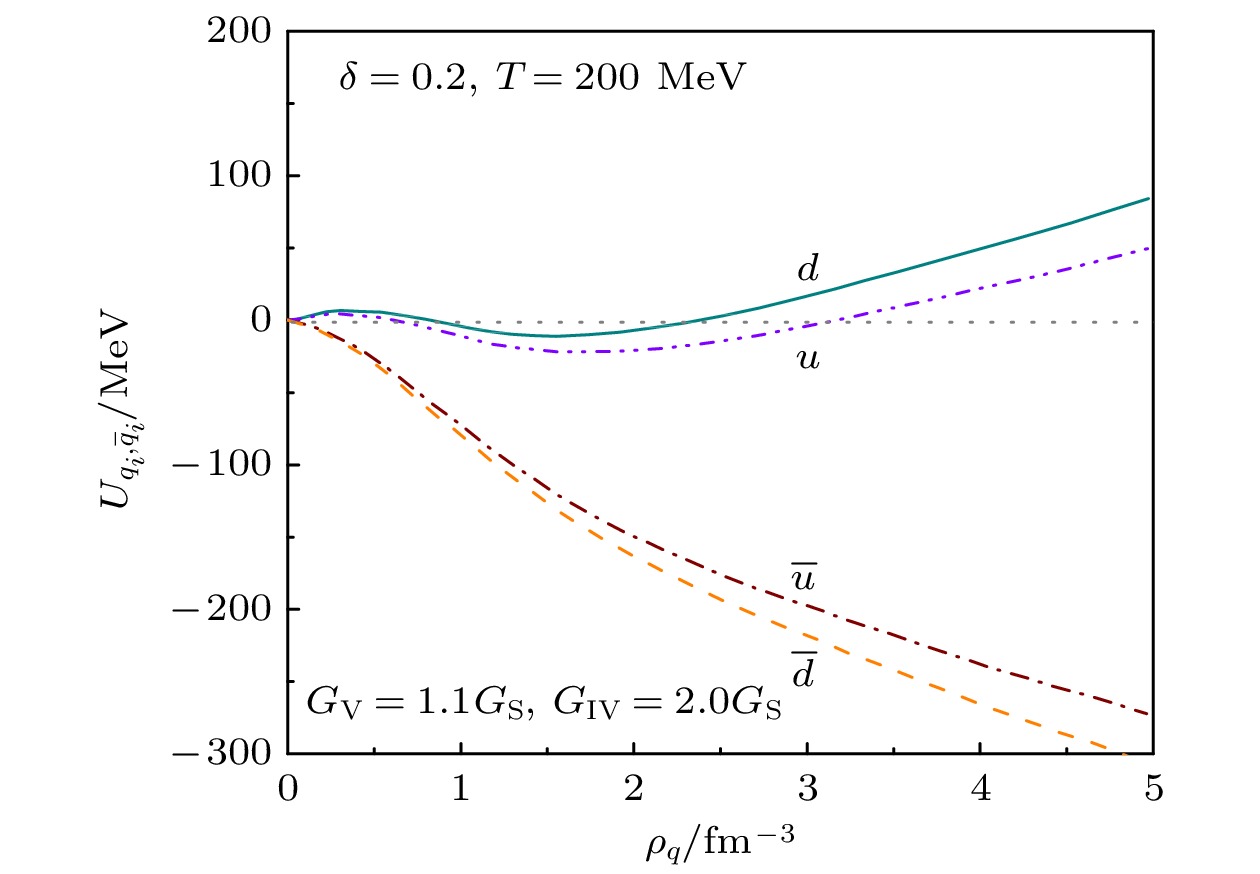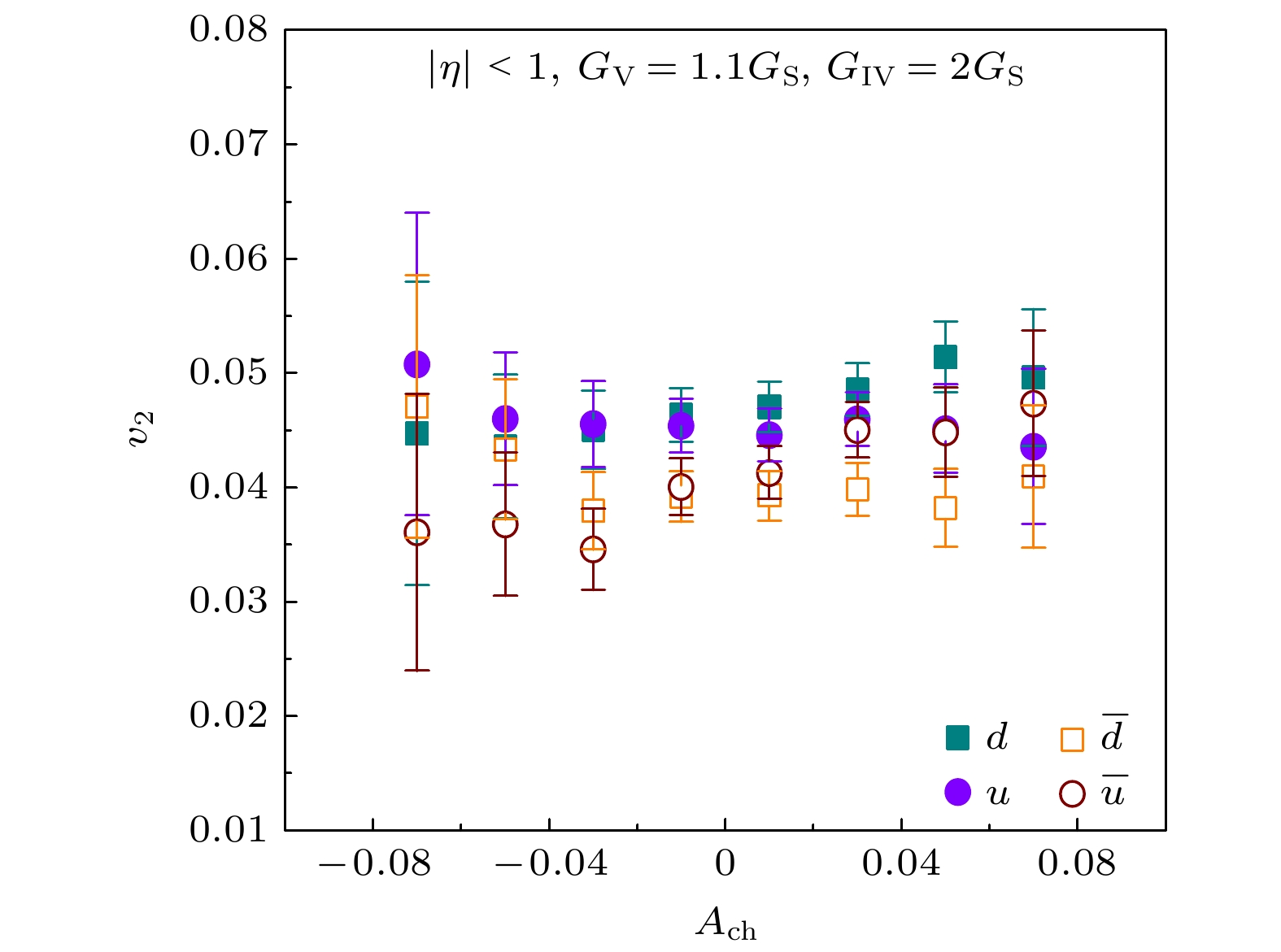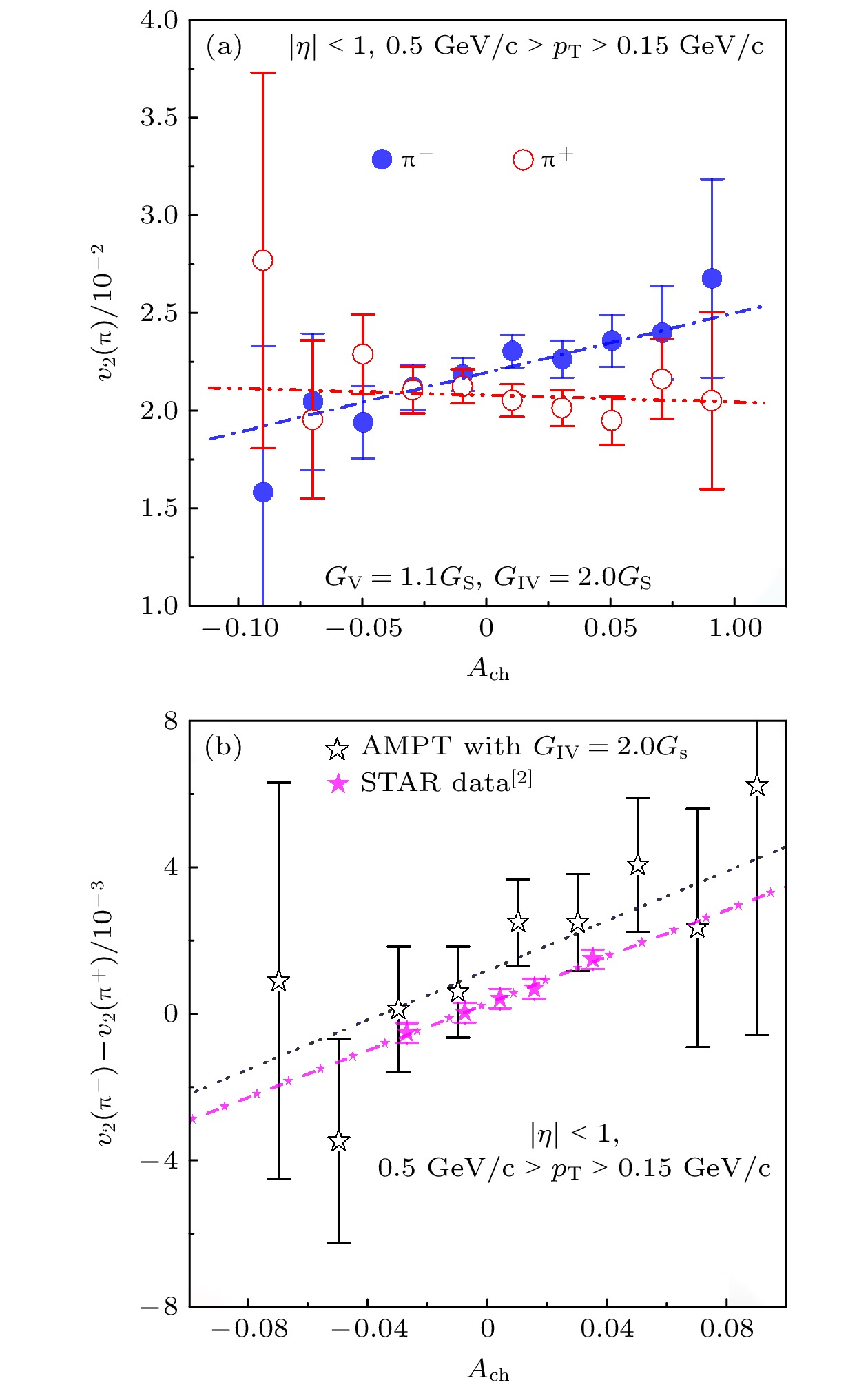-
Relativistic heavy-ion collisions are an important experimental way of studying the new state of matter as well as the phase diagram of the quantum chromodynamics (QCD) under extremely high temperatures and high densities. In recent years, the beam-energy scan program has been carried out on the relativistic heavy-ion collider at Brookhaven National Laboratory in USA, and the STAR collaboration at relativistic heavy ion collision (RHIC) has measured the difference in the elliptic flow
$v_2$ between$\pi^-$ and$\pi^+$ on an event-by-event basis, and found a linear dependence on the charge asymmetry Ach of the collision system, which is considered as a possible signal of the chiral magnetic wave. Based on the extended multi-phase transport model (AMPT), this paper uses a 3 flavor Nambu-Jona-Lasinio (NJL) model to study the quark isospin Mean-field potential, which provides a new idea for explaining the experimental phenomenon of the linear relationship between the pion elliptic flow splitting$\Delta v_2=v_2(\pi^-)- $ $ v_2(\pi^+)$ and charge asymmetry Ach. Our results show that isovector interaction can cause a splitting of the isospin asymmetric quark matter mean-field potential, manifesting as$d(\bar{u})$ quarks experiencing a mean-field potential greater than$u(\bar{d})$ quarks. Therefore,$d(\bar{u})$ quarks experience more repulsion than$u(\bar{d})$ quarks in collision processes, resulting in a small increase in the elliptic flow of the partial subflow$v_2(d)$ and$v_2(\bar{u})$ , while$v_2(u)$ and$v_2(\bar{d})$ decrease slightly. In the hadronization process, the$\pi$ elliptic flow splitting occurs due to the split of$d$ and$u$ elliptic flows combined with the split of$\bar{u}$ and$\bar{d}$ elliptic flows. We also found a linear correlation between charge asymmetry and isospin asymmetry at mid-rapidity region from our transport model, and thus explained the experimental phenomenon of the linear relationship between the pion elliptic flow splitting$\Delta v_2$ and charge asymmetry Ach by using the isospin mean-field potential of quark matter. Further, isospin properties of quark matter also provide a theoretical basis for isobar collisions and the equation of state of compact star matter.-
Keywords:
- relativistic heavy-ion collisions /
- isospin /
- elliptic flow /
- a multi-phase transport model
[1] Adamczyk L, et al. (STAR Collaboration) 2013 Phys. Rev. Lett. 110 142301
[2] Adamczyk L, et al. (STAR Collaboration) 2015 Phys. Rev. Lett. 114 252302
[3] Burnier Y, Kharzeev D E, Liao J, Yee H U 2011 Phys. Rev. Lett. 107 052303
 Google Scholar
Google Scholar
[4] Hatta Y, Monnai A, Xiao B W 2015 Phys. Rev. D 92 114010
 Google Scholar
Google Scholar
[5] Hatta Y, Monnai A, Xiao B W 2016 Nucl. Phys. A 947 155
 Google Scholar
Google Scholar
[6] Adams J, Adler C, Aggarwal M M, et al. 2004 Phys. Rev. Lett. 92 052302
 Google Scholar
Google Scholar
[7] Adams J, Aggarwal M M, Ahammed Z, et al. 2005 Phys. Rev. C 72 014904
 Google Scholar
Google Scholar
[8] Adare A, Afanasiev S, Aidala C, et al. 2007 Phys. Rev. Lett. 98 162301
 Google Scholar
Google Scholar
[9] Afanasiev S, Aidala C, Ajitanand N N, et al. 2007 Phys. Rev. Lett. 99 052301
 Google Scholar
Google Scholar
[10] Xu J, Chen L W, Ko C M, Lin Z W 2012 Phys. Rev. C 85 041901
 Google Scholar
Google Scholar
[11] Xu J, Song T, Ko C M, Li F 2014 Phys. Rev. Lett. 112 012301
 Google Scholar
Google Scholar
[12] Ko C M, Song T, Li F, Greco V, Plumari S 2014 Nucl. Phys. A 928 234
 Google Scholar
Google Scholar
[13] Liu H, Wang F T, Sun K J, et al. 2019 Phys. Lett. B 798 135002
 Google Scholar
Google Scholar
[14] Lattimer J M, Prakash M 2007 Phys. Rep. 442 109
 Google Scholar
Google Scholar
[15] Steiner A W, Prakash M, Lattimer J M, Ellis P J 2005 Phys. Rep. 411 325
 Google Scholar
Google Scholar
[16] Li B A, Chen L W, Ko C M 2008 Phys. Rep. 464 113
 Google Scholar
Google Scholar
[17] Horowitz C J, Brown E F, Kim Y, et al. 2014 J. Phys. G 41 093001
 Google Scholar
Google Scholar
[18] Lin Z W, Ko C M, Li B A, Zhang B, Pal S 2005 Phys. Rev. C 72 064901
 Google Scholar
Google Scholar
[19] Wong C Y 1982 Phys. Rev. C 25 1460
 Google Scholar
Google Scholar
[20] Bertsch G F, Gupta S D 1988 Phys. Rep. 160 189
 Google Scholar
Google Scholar
[21] Liu H, Xu J, Chen L W, et al. 2016 Phys. Rev. D 94 065032
 Google Scholar
Google Scholar
[22] Batovic N, Hatsuda T, Weise W 2013 Phys. Lett. B 719 131
 Google Scholar
Google Scholar
[23] Karsch F 2002 Lect. Notes. Phys. 583 209
 Google Scholar
Google Scholar
[24] Gupta S, Luo X, Mohanty B, et al. 2011 Science 332 1525
 Google Scholar
Google Scholar
[25] Battacharya T, Buchoff M I, Christ N H, et al. 2014 Phys. Rev. Lett. 113 082001
 Google Scholar
Google Scholar
[26] Xu H j, Wang X, Li H, et al. 2018 Phys. Rev. Lett. 121 022301
 Google Scholar
Google Scholar
[27] Li H L, Xu H J, Zhou Y, et al. 2020 Phys. Rev. Lett. 125 222301
 Google Scholar
Google Scholar
[28] Koch V, Schlichting S, Skokov V, et al. 2017 Chin. Phys. C 41 072001
 Google Scholar
Google Scholar
[29] Liang G R, Liao J, Lin S, Yan L, Li M 2020 Chin. Phys. C 44 094103
 Google Scholar
Google Scholar
-
图 2 在质心系能量为
$ \sqrt{s_{NN}} =200 $ GeV, 碰撞中心度为30%—40%的Au+Au碰撞中, 不同同位旋不对称度区间的体系中心区域各部分子密度随时间的演化 (a)$ \delta = 0.1 $ ; (b)$ \delta = 0.2 $ ; (c)$ \delta = 0.3 $ Fig. 2. Central number densities of partons as a function of time in centrality 30%—40% Au + Au collisions at collision energies
$ \sqrt{s_{NN}} =200 $ GeV for the cases of including different isospin asymmetries: (a)$ \delta = 0.1 $ ; (b)$ \delta = 0.2 $ ; (c)$ \delta = 0.3 $ .图 5 在质心不变碰撞能量为200 GeV, 中心度30%—40%的Au+Au碰撞中 (a)
$ \pi $ 介子椭圆流与末态强子电荷不对称度的依赖关系; (b)$ \pi $ 介子椭圆流劈裂与末态强子电荷不对称度的依赖关系Fig. 5. For 30%–40% central Au+Au collisions at 200 GeV: (a) Pion
$ v_2 $ as a function of final hadron charge asymmetry; (b)$ v_2 $ difference between$ \pi^+ $ 和$ \pi^- $ as a function of final hadron charge asymmetry. -
[1] Adamczyk L, et al. (STAR Collaboration) 2013 Phys. Rev. Lett. 110 142301
[2] Adamczyk L, et al. (STAR Collaboration) 2015 Phys. Rev. Lett. 114 252302
[3] Burnier Y, Kharzeev D E, Liao J, Yee H U 2011 Phys. Rev. Lett. 107 052303
 Google Scholar
Google Scholar
[4] Hatta Y, Monnai A, Xiao B W 2015 Phys. Rev. D 92 114010
 Google Scholar
Google Scholar
[5] Hatta Y, Monnai A, Xiao B W 2016 Nucl. Phys. A 947 155
 Google Scholar
Google Scholar
[6] Adams J, Adler C, Aggarwal M M, et al. 2004 Phys. Rev. Lett. 92 052302
 Google Scholar
Google Scholar
[7] Adams J, Aggarwal M M, Ahammed Z, et al. 2005 Phys. Rev. C 72 014904
 Google Scholar
Google Scholar
[8] Adare A, Afanasiev S, Aidala C, et al. 2007 Phys. Rev. Lett. 98 162301
 Google Scholar
Google Scholar
[9] Afanasiev S, Aidala C, Ajitanand N N, et al. 2007 Phys. Rev. Lett. 99 052301
 Google Scholar
Google Scholar
[10] Xu J, Chen L W, Ko C M, Lin Z W 2012 Phys. Rev. C 85 041901
 Google Scholar
Google Scholar
[11] Xu J, Song T, Ko C M, Li F 2014 Phys. Rev. Lett. 112 012301
 Google Scholar
Google Scholar
[12] Ko C M, Song T, Li F, Greco V, Plumari S 2014 Nucl. Phys. A 928 234
 Google Scholar
Google Scholar
[13] Liu H, Wang F T, Sun K J, et al. 2019 Phys. Lett. B 798 135002
 Google Scholar
Google Scholar
[14] Lattimer J M, Prakash M 2007 Phys. Rep. 442 109
 Google Scholar
Google Scholar
[15] Steiner A W, Prakash M, Lattimer J M, Ellis P J 2005 Phys. Rep. 411 325
 Google Scholar
Google Scholar
[16] Li B A, Chen L W, Ko C M 2008 Phys. Rep. 464 113
 Google Scholar
Google Scholar
[17] Horowitz C J, Brown E F, Kim Y, et al. 2014 J. Phys. G 41 093001
 Google Scholar
Google Scholar
[18] Lin Z W, Ko C M, Li B A, Zhang B, Pal S 2005 Phys. Rev. C 72 064901
 Google Scholar
Google Scholar
[19] Wong C Y 1982 Phys. Rev. C 25 1460
 Google Scholar
Google Scholar
[20] Bertsch G F, Gupta S D 1988 Phys. Rep. 160 189
 Google Scholar
Google Scholar
[21] Liu H, Xu J, Chen L W, et al. 2016 Phys. Rev. D 94 065032
 Google Scholar
Google Scholar
[22] Batovic N, Hatsuda T, Weise W 2013 Phys. Lett. B 719 131
 Google Scholar
Google Scholar
[23] Karsch F 2002 Lect. Notes. Phys. 583 209
 Google Scholar
Google Scholar
[24] Gupta S, Luo X, Mohanty B, et al. 2011 Science 332 1525
 Google Scholar
Google Scholar
[25] Battacharya T, Buchoff M I, Christ N H, et al. 2014 Phys. Rev. Lett. 113 082001
 Google Scholar
Google Scholar
[26] Xu H j, Wang X, Li H, et al. 2018 Phys. Rev. Lett. 121 022301
 Google Scholar
Google Scholar
[27] Li H L, Xu H J, Zhou Y, et al. 2020 Phys. Rev. Lett. 125 222301
 Google Scholar
Google Scholar
[28] Koch V, Schlichting S, Skokov V, et al. 2017 Chin. Phys. C 41 072001
 Google Scholar
Google Scholar
[29] Liang G R, Liao J, Lin S, Yan L, Li M 2020 Chin. Phys. C 44 094103
 Google Scholar
Google Scholar
计量
- 文章访问数: 5814
- PDF下载量: 79
- 被引次数: 0


































 下载:
下载:






















